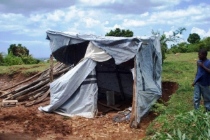
HFI ahead of schedule on Houses of Hope project
September 11, 2012
 After the torrential rains of Tropical Storm Isaac drenched the Caribbean island of Haiti in late August, the nation's recovery and reconstruction have once again been pushed a step back by natural disaster. With 400,000 people still living in tent cities and thousands more making their homes in the slums or makeshift shacks after the 2010 earthquake, Haiti's housing conditions left many in a vulnerable situation as the storm approached.
After the torrential rains of Tropical Storm Isaac drenched the Caribbean island of Haiti in late August, the nation's recovery and reconstruction have once again been pushed a step back by natural disaster. With 400,000 people still living in tent cities and thousands more making their homes in the slums or makeshift shacks after the 2010 earthquake, Haiti's housing conditions left many in a vulnerable situation as the storm approached.
"Throughout the city there are people in slums with notoriously bad living conditions," Hope Force Field Team member René Lako said. "Even before the earthquake, many lived in shacks, which are prone to leakage and get damaged in heavy rains and strong winds. Despite the construction of several thousand transitional shelters, there are still thousands who live in appalling conditions. In a storm like Isaac, the rain can create serious suffering as people have no protection from the elements."
But for many people living in Sous Savanne and the nearby rural community of Babay, shelter was not an issue in the face of the recent tropical storm -- already 11 families have been given a safe, durable home through the "Houses of Hope" project. After beginning construction on the twelfth "House of Hope," HFI is officially ahead of schedule on the initiative.
 This twelfth home is being built for a Haitian woman named Liliane and her two children. When their home was destroyed in the earthquake, the family continued to live in the remains of the house for six months and then moved into a makeshift shelter against a grassy hill. The structure was made of mismatched pieces of wood with a tarp roof. When it rained, Liliane put out cups to collect water that came in through holes in the tarp and leaned the family's only mattress against the wall to keep it from being completely soaked.
This twelfth home is being built for a Haitian woman named Liliane and her two children. When their home was destroyed in the earthquake, the family continued to live in the remains of the house for six months and then moved into a makeshift shelter against a grassy hill. The structure was made of mismatched pieces of wood with a tarp roof. When it rained, Liliane put out cups to collect water that came in through holes in the tarp and leaned the family's only mattress against the wall to keep it from being completely soaked.
According to René, "When I saw the shelter, I asked my coworker Joseph, 'Nobody lives there, right' What's that heap of tarps doing next to the piece of roof?" Then we saw a woman in a bright yellow dress come out from under the tarp. We came closer to check out the situation and met Liliane. Hers is one of the smallest, flimsiest shacks I had ever seen.
After realizing that the structure was in fact serving as a home to Liliane and her children, René signed the family up as recipients of the twelfth "House of Hope." The foundation of the house was laid prior to Tropical Storm Isaac's arrival, and the walls will go up as soon as conditions allow.
 "In just a few weeks, Liliane and her kids will have themselves a cement block house where they can always lay down to rest their heads, no matter the weather," HFI Reservist Casey said. "She is very excited to have a new home and still be across the street from her church. Haiti may not provide the care that single mothers so desperately need, but God has provided ways for them to survive. With help from organizations like Hope Force, willing missionaries, loads of prayer, and courageous Haitian women, there is hope for the hopeless in the village of Sous Savanne."
"In just a few weeks, Liliane and her kids will have themselves a cement block house where they can always lay down to rest their heads, no matter the weather," HFI Reservist Casey said. "She is very excited to have a new home and still be across the street from her church. Haiti may not provide the care that single mothers so desperately need, but God has provided ways for them to survive. With help from organizations like Hope Force, willing missionaries, loads of prayer, and courageous Haitian women, there is hope for the hopeless in the village of Sous Savanne."
"Houses of Hope" kicked off in April with the construction of the first two housing units. In May, Hope Force sent 16 players from the University of Southern California Trojan football team to complete the next homes, as well as paint existing homes. Over the course of their five-day trip, the team built four homes for families in the Child Sponsorship Program who were still in desperate need of improved living conditions. Four more homes were completed in July by teams from churches in Nashville, Philadelphia and Atlanta.
"Houses of Hope" has undergone a change as we transition from using wooden housing kits to a block home design. The new block home design has lightweight roofs that are locked together with the main structure using trusses and metal roofing, making them both strong and safe.





